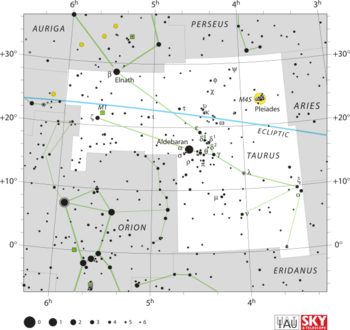Astronomy:10 Tauri
| Observation data Equinox J2000.0]] (ICRS) | |
|---|---|
| Constellation | Taurus |
| Right ascension | 03h 36m 52.38s[1] |
| Declination | +00° 24′ 06.0″[1] |
| Apparent magnitude (V) | 4.29[2] |
| Characteristics | |
| Spectral type | F8 V[3] |
| U−B color index | +0.08[2] |
| B−V color index | +0.58[2] |
| Astrometry | |
| Radial velocity (Rv) | +27.8±0.5[4] km/s |
| Proper motion (μ) | RA: −232.60±0.59[1] mas/yr Dec.: −481.92±0.54[1] mas/yr |
| Parallax (π) | 71.62 ± 0.54[1] mas |
| Distance | 45.5 ± 0.3 ly (14.0 ± 0.1 pc) |
| Absolute magnitude (MV) | +3.60[5] |
| Details[6] | |
| Mass | 1.139±0.016 M☉ |
| Radius | 1.622±0.024 R☉ |
| Luminosity | 3.042±0.042 L☉ |
| Surface gravity (log g) | 4.07±0.05[7] cgs |
| Temperature | 5,997±44 K |
| Metallicity [Fe/H] | −0.12±0.07[8] dex |
| Rotation | 17.6 days[9] |
| Rotational velocity (v sin i) | 2.4[5] km/s |
| Age | 5.7±0.4 Gyr |
| Other designations | |
| Database references | |
| SIMBAD | data |
10 Tauri is a single[10] star in the zodiac constellation of Taurus. It can be seen with the naked eye, having an apparent visual magnitude of 4.29.[2] An annual parallax shift of 71.62[1] mas provides a distance estimate of 45.5 light years. It is moving further from the Sun with a radial velocity of +28 km/s[4] and has a relatively high proper motion.[2]
The star has a stellar classification of F8 V,[3] indicating that it is an ordinary F-type main-sequence star that is generating energy through hydrogen fusion in its core region. It is around 5.7[6] billion years old with a rotation period of 17.6 days.[9] The star has 1.14 times the mass of the Sun and 1.6 times the Sun's radius. It is radiating three times the Sun's luminosity from its photosphere at an effective temperature of around 5,997 K.[6]
A debris disk has been identified orbiting 10 Tauri, based on excess infrared radiation detected by IRAS/ISO.[11]
10 Tauri was the brightest star in the obsolete constellation Psalterium Georgii (Harpa Georgii).[12]
References
- ↑ 1.0 1.1 1.2 1.3 1.4 1.5 van Leeuwen, F. (2007). "Validation of the new Hipparcos reduction". Astronomy and Astrophysics 474 (2): 653–664. doi:10.1051/0004-6361:20078357. Bibcode: 2007A&A...474..653V. http://www.aanda.org/index.php?option=com_article&access=bibcode&Itemid=129&bibcode=2007A%2526A...474..653VFUL. Vizier catalog entry
- ↑ 2.0 2.1 2.2 2.3 2.4 Cowley, A. P. et al. (December 1967), "Spectral classification and photometry of high proper motion stars", Astronomical Journal 72: 1334−1340, doi:10.1086/110413, Bibcode: 1967AJ.....72.1334C.
- ↑ 3.0 3.1 Houk, N.; Swift, C. (1999), "Michigan catalogue of two-dimensional spectral types for the HD Stars", Michigan Spectral Survey 5, Bibcode: 1999MSS...C05....0H.
- ↑ 4.0 4.1 Nordström, B. et al. (May 2014), "The Geneva-Copenhagen survey of the Solar neighbourhood. Ages, metallicities, and kinematic properties of ~14000 F and G dwarfs", Astronomy and Astrophysics 418: 989–1019, doi:10.1051/0004-6361:20035959, Bibcode: 2004A&A...418..989N.
- ↑ 5.0 5.1 Pizzolato, N.; Maggio, A.; Sciortino, S. (September 2000), "Evolution of X-ray activity of 1-3 Msun late-type stars in early post-main-sequence phases", Astronomy and Astrophysics 361: 614–628, Bibcode: 2000A&A...361..614P
- ↑ 6.0 6.1 6.2 Boyajian, Tabetha S. et al. (February 2012), "Stellar Diameters and Temperatures. I. Main-sequence A, F, and G Stars", The Astrophysical Journal 746 (1): 101, doi:10.1088/0004-637X/746/1/101, Bibcode: 2012ApJ...746..101B. See Table 10.
- ↑ Sitnova, T. et al. (August 2015), "Systematic Non-LTE Study of the -2.6 < [Fe/H] < 0.2 F and G dwarfs in the Solar Neighborhood. I. Stellar Atmosphere Parameters", The Astrophysical Journal 808 (2): 17, doi:10.1088/0004-637X/808/2/148, 148, Bibcode: 2015ApJ...808..148S.
- ↑ Fuhrmann, Klaus (February 2008), "Nearby stars of the Galactic disc and halo - IV", Monthly Notices of the Royal Astronomical Society 384 (1): 173–224, doi:10.1111/j.1365-2966.2007.12671.x, Bibcode: 2008MNRAS.384..173F
- ↑ 9.0 9.1 Maldonado, J. et al. (October 2010), "A spectroscopy study of nearby late-type stars, possible members of stellar kinematic groups", Astronomy and Astrophysics 521: A12, doi:10.1051/0004-6361/201014948, Bibcode: 2010A&A...521A..12M
- ↑ Rodriguez, David R. et al. (May 2015), "Stellar multiplicity and debris discs: an unbiased sample", Monthly Notices of the Royal Astronomical Society 449 (3): 3160–3170, doi:10.1093/mnras/stv483, Bibcode: 2015MNRAS.449.3160R.
- ↑ J.S. Greaves; D.A. Fischer; M.C. Wyatt (2006). "Metallicity, Debris Discs and Planets". Monthly Notices of the Royal Astronomical Society 366 (1): 283–286. doi:10.1111/j.1365-2966.2005.09848.x. Bibcode: 2006MNRAS.366..283G. http://www.astro.washington.edu/courses/astro421/SciPapers/StarFormation/metallicity_debrisdisks.pdf.
- ↑ Ian Ridpath's Star Tales - Psalterium Georgii
External links
- "* 10 Tau". SIMBAD. Centre de données astronomiques de Strasbourg. http://simbad.u-strasbg.fr/simbad/sim-basic?Ident=%2A+10+Tau.
- "4C00315". ARICNS. 1998-03-04. http://www.ari.uni-heidelberg.de/datenbanken/aricns/cnspages/4c00315.htm. Retrieved 2006-08-10.
- "10 Tauri". Internet Stellar Database. http://www.stellar-database.com/Scripts/search_star.exe?ID=25500. Retrieved 2006-08-10.
 |


